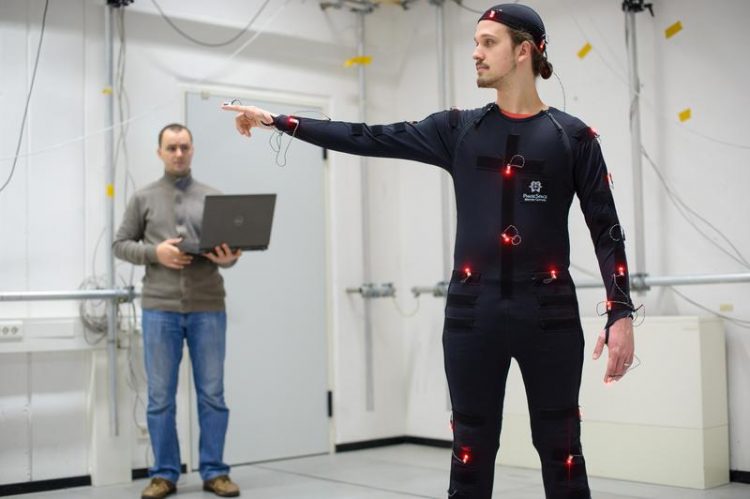Cebit 2015: Simulations show how using tablets and smartphones puts stress on joints and muscles

To carry out the simulation, the researchers use software to map these movements onto a model of the human body. Credit: Oliver Dietze
Tense shoulders, neck strain or a painful wrist are not uncommon among those who spend long periods of time working at a computer. Indeed, this sort of problem can also arise when using the newer types of IT devices that have appeared on the market over the last few years.
For example, the use of gestures to control games consoles can cause particularly high levels of stress to shoulders or knees. Touch screens that require users to hold their arm in an extended position for long periods of time can also be problematic – experts refer to this specific type of muscle fatigue as ‘gorilla arm’.
To help designers and developers of new IT devices take into account those movements that create unnecessary bodily strain, graduate researcher Myroslav Bachynskyi and his colleagues have developed a tool that enables realistic simulation of user movements. ‘Our approach combines three-dimensional motion capture with biomechanical simulation,’ explains Bachynskyi, a PhD student at the Saarbrücken Cluster of Excellence and the Max Planck Institute for Informatics.
In optical motion capture a test subject wearing a special suit equipped with small optical markers performs a particular sequence of movements, such as waving his or her arms in order to control a computer game. The markers on the suit emit light that is recorded by special cameras. ‘To carry out the simulation, we use software to map these movements onto a model of the human body,’ says Bachynskyi.
To shed light on the actual biomechanical loads acting on specific body parts, the simulation program calculates a number of key parameters: the joint angles, the forces acting on the joints at any time during the movement, as well as muscle activation and fatigue. ‘The model allows us to see precisely which part of the body is subjected to the greatest loading when a particular movement is performed, and so we can determine whether, say, the upper arm muscles or the elbow are under particular strain,’ explains Bachynskyi.
‘Our method also shows us how efficiently, that is, how quickly and accurately a user operates a particular piece of IT equipment.’ The method offers a possibility to find an optimal combination of user performance and physical ergonomics.
One of the cases studied by the researchers was how users interacted with a wall-mounted vertical touch screen. They found that movements from left to right and from top to bottom put less stress on the muscles than forward and backward movements. They conclude that a virtual keyboard is therefore best positioned in the lower central part of the screen.
Designers can exploit this new analysis method to improve user interaction with their products. The methodology is also of interest in occupational medicine and in industry, where it can be used to improve the design of workplaces in large computer-assisted production facilities.
Computer science and informatics at Saarland University
The Department of Computer Science forms the core of the informatics landscape at Saarland University. A further seven internationally renowned research institutes are located in the immediate vicinity on campus. As well as the two Max Planck Institutes for Informatics and for Software Systems, the Saarbrücken campus is also home to the German Research Center for Artificial Intelligence, the Intel Visual Computing Institute, the Center for IT Security, Privacy and Accountability (CISPA) and the Cluster of Excellence ‘Multimodal Computing and Interaction’.
Myroslav Bachynskyi is a doctoral research student at Saarland University and a member of the Saarbrücken Graduate School of Computer Science.
For more information about the research work, please go to: http://resources.mpi-inf.mpg.de/biomechanics/
Questions can be addressed to:
Myroslav Bachynskyi
Cluster of Excellence ‘Multimodal Computing and Interaction’
Tel.: +49 (0)681 302-71929
E-mail: mbachyns(at)mpi-inf.mpg.de
Media Contact
More Information:
http://www.uni-saarland.deAll latest news from the category: Trade Fair News
Newest articles

Parallel Paths: Understanding Malaria Resistance in Chimpanzees and Humans
The closest relatives of humans adapt genetically to habitats and infections Survival of the Fittest: Genetic Adaptations Uncovered in Chimpanzees Görlitz, 10.01.2025. Chimpanzees have genetic adaptations that help them survive…

You are What You Eat—Stanford Study Links Fiber to Anti-Cancer Gene Modulation
The Fiber Gap: A Growing Concern in American Diets Fiber is well known to be an important part of a healthy diet, yet less than 10% of Americans eat the minimum recommended…

Trust Your Gut—RNA-Protein Discovery for Better Immunity
HIRI researchers uncover control mechanisms of polysaccharide utilization in Bacteroides thetaiotaomicron. Researchers at the Helmholtz Institute for RNA-based Infection Research (HIRI) and the Julius-Maximilians-Universität (JMU) in Würzburg have identified a…



